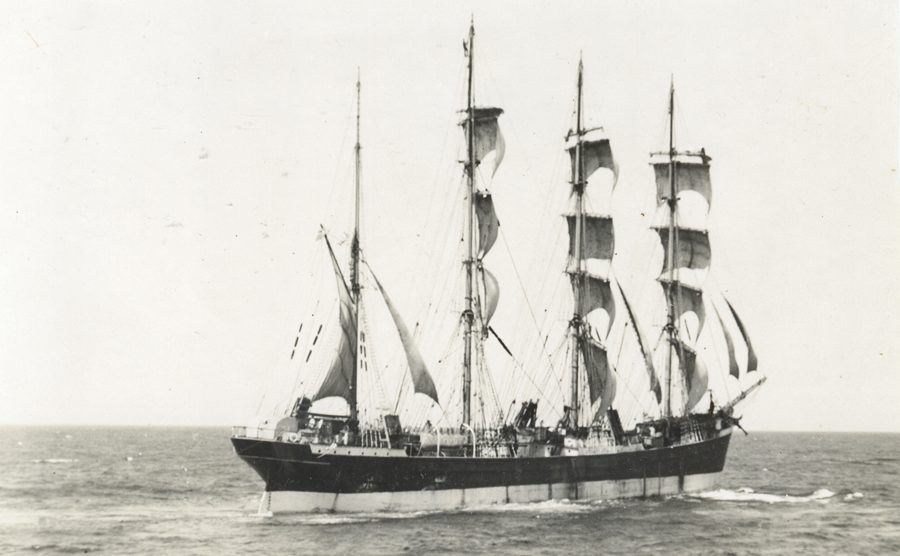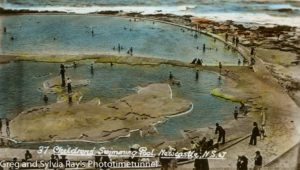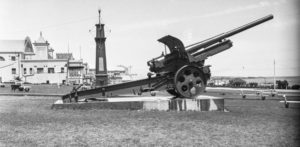On September 9, 1944, when the veteran four-masted barque Lawhill arrived at Newcastle, NSW, on a trading visit, the city must have responded with excitement. With the world still at war – although by now it was clear the Allies were on the front foot in both Europe against Germany and the Pacific against Japan – the appearance of a big sailing ship would have taken the minds of old-timers back to their youth, when such vessels were regular visitors in the busy harbour. Younger people would have realised too, that this was likely to be a last hurrah, and they should drink in the sight of this tall ship while they had the chance. Indeed, although various other veteran sailers have visited the port in the years since, their missions have been ceremonial or historical. The Lawhill was almost certainly the last of its kind to visit Newcastle on a strictly commercial basis.


Although the Lawhill’s visit to Sydney that year was marked by press articles, the ship’s visit to Newcastle was not documented in either of the city’s daily newspapers until after it had left. This was presumably a result of wartime censorship. It had been accepted over the course of the war that “loose lips sink ships” and although the Japanese submarine menace had well and truly receded by late 1944, it seems the authorities in Newcastle decided to maintain their policy of not publicising the movements of particular ships.

Nevertheless, many photographs – and even some film footage – are tangible testimony to the enthusiasm surrounding the Lawhill’s visit. A Newcastle reporter evidently went aboard during the ship’s visit, but their account remained unpublished until February 21, 1945. The report describes the captain’s quarters where: “grained wood, much like cedar, lined the walls. A mantel radio was playing a popular air. Australian waratahs were in vases on a magnificent velvet table cloth. Thick carpet covered the floor. Chairs and settee were upholstered in blue leather. A kerosene lamp swung from the ceiling, and a bronze plaque of Mr Churchill looked down on it all.” The ship had a crew of 43, including six Australian boys and carried two well-fed dogs. The captain, Artur Soderlund, had had his wife and daughter aboard since 1940. According to the report: “The Lawhill was towed to sea when she left Newcastle. A tug took her well over the bar into a favourable trade wind. Slowly the sails were unfurled. The ship heeled to the breeze. One of the last of the windjammers sailed away”.


The Lawhill was quite a famous ship, being as it was one of the last of its kind. Ships like the Lawhill are considered by historians to have represented the pinnacle of sailing technology and by a combination of strength, carrying capacity and economy of operation they did not easily yield their place on the world’s oceans to the steamships and oil-burners of the newer era. The ship was nicknamed “the Lucky Lawhill” – quite apt for such a vulnerable vessel which managed to survive both world wars, during which scores of ships, including many old sailers, were sent to the bottom by torpedo, bomb and gunfire.
Built in Dundee, Scotland, in August 1892, and named for a prominent hill in that city, the Lawhill was intended for the trade in jute, a fibre product traded from the Indian subcontinent. It was too late for this trade, however, and was sold for use in carrying cased oil for the Anglo American Oil Company. In 1914 the ship passed to Finnish owners and, after managing to deliver Australian wheat to Brest in 1917, it was laid up until 1919. The ship was a commercially successful operation for its owners until World War 2, and was a regular visitor to Australian ports, including Newcastle, from where it carried the port’s major cargo – coal.

In 1941, in the complicated throes of war when Russia invaded Finland, Russia’s status as an ally against Germany meant Finland was an enemy of the British bloc. Finnish assets abroad were liable to seizure, and the Lawhill was nabbed by South Africa, under which flag it operated during the war on trading voyages between South Africa and Australia. It was sailing under the South African flag when it came to Newcastle, via Sydney (where it had delivered a cargo of cocoa beans), in 1944. It had spent a month in Sydney before it came to Newcastle for general cargo. It stayed in Newcastle from September 9 to October 12 before sailing off to Table Bay, South Africa, via Adelaide. That was the Lawhill’s 46th voyage, and it was destined to make only four more. Its 47th voyage brought it back to Australia. It was in Hobart in July 1945, from where it carried apples and jam to Sydney before heading to Bunbury, Western Australia, for a cargo of wheat and sleepers for South Africa. Lawhill left Bunbury in January 1946 and never returned to Australia.
After the war the ship struggled to pay its way and it wound up in Portuguese ownership and was left to rot in the swamps of Mozambique, Africa – then a Portuguese colonial possession. Eventually its hull was cut up and sent to Japan as scrap.
The Lawhill is a remarkably well-documented vessel. During the 1930s, ship enthusiast Richard Cookson went aboard and made an extraordinary record, in photographs, sketches and notes, of many aspects of the ship’s construction, rigging and other gear. This record became the basis of the book, The Four-Masted Barque Lawhill, by Kenneth Edwards, Roderick Anderson and Richard Cookson, in the Anatomy of the Ship series published by Conway Maritime Press in 1996. A model of the ship can be seen here.
In volume 2 of his 1929 book, The Last of the Windjammers, Basil Lubbock describes the Lawhill as “an exceptional vessel”, based on its reliable performance, typically good speed and its unusual but very helpful upper rigging arrangement.
Rare colour film of the Lawhill’s visit
Newcastle Herald photographer Cec Piggott made some colour film of the Lawhill’s visit. One edit (titled One of the Few) was reportedly shown by Mr Piggott in Newcastle in 1945 (among other of his productions), and a later edit (titled Last of the Windjammers – rescued some years ago from a rubbish tip by licensed scavenger Raye Rowe) was digitized by Newcastle Maritime Centre and can be viewed online here.



